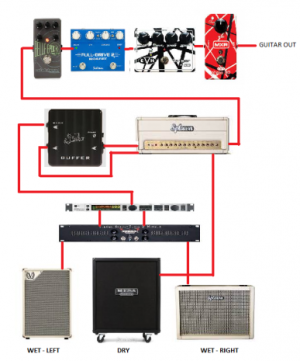PFDarkside
of the Forum
I’ve been listening to a lot of Van Hagar, man Eddie’s tone really got huge. I was thinking, I can probably build a Wet/Dry/Wet rig like he was using with the stuff I have.
Step 1: Use the appropriate pedals, Phase 90, Flanger, Tape Echo and an OD for boost. (Do I need a chorus in front?)
Step 2: Splawn Quickrod does a pretty awesome modded Marshall tone
Step 3: Split the signal in the effects loop, returning the “dry” signal into the Splawn and out to a cabinet
Step 4: Send the buffered, ISO out to the G-Major 2, set to 100% Mix, used for Stereo Detune, Stereo Delay and Stereo Chorus
Step 5: send Stereo output of the G-Major 2 to a Mesa 2:90 and to two cabinets
The only things I don’t own are the buffer box for isolated splitting and some patch cables to get it all wired up.
Am I missing anything?

Step 1: Use the appropriate pedals, Phase 90, Flanger, Tape Echo and an OD for boost. (Do I need a chorus in front?)
Step 2: Splawn Quickrod does a pretty awesome modded Marshall tone
Step 3: Split the signal in the effects loop, returning the “dry” signal into the Splawn and out to a cabinet
Step 4: Send the buffered, ISO out to the G-Major 2, set to 100% Mix, used for Stereo Detune, Stereo Delay and Stereo Chorus
Step 5: send Stereo output of the G-Major 2 to a Mesa 2:90 and to two cabinets
The only things I don’t own are the buffer box for isolated splitting and some patch cables to get it all wired up.
Am I missing anything?

